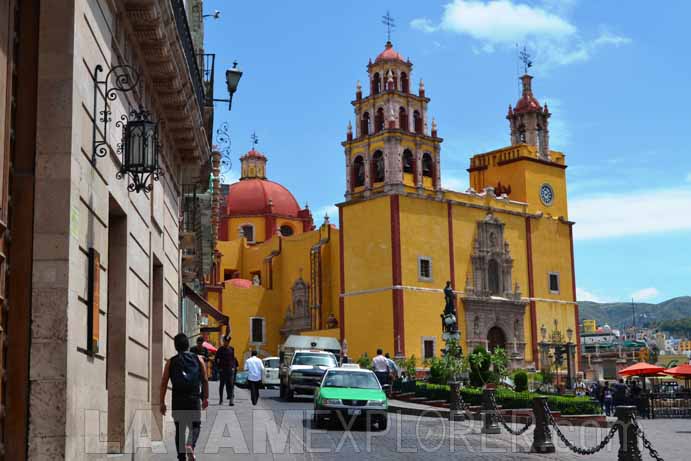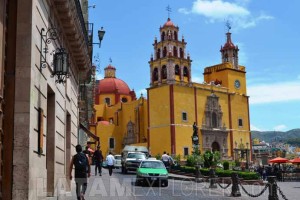Home > Destinations > Mexico > Guanajuato
Guanajuato, Mexico
Capital of the homonymous state, the city of Guanajuato has a great history associated to the mining activity, besides being one of the birthplaces of the Mexican independence movement - the city is a World Heritage Site, as declared by UNESCO. Located 360km (225mi) away from Mexico City and 270km (170mi) away from Guadalajara, it is served by Léon's airport.
Guanajuato presents a distinctive geography. Its 170,000 inhabitants are distributed through an irregular layout that engulfs the hills existing in the area. The several neighborhoods of the city are connected by a series of tunnels that, along with its several squares and steep streets concede a special atmosphere to the place. A very popular feature of Guanajuato is the existence of several estudiantinas, music groups formed by students who wander through certain areas of the city while cheering the crowd - this is an excellent way of having an alternative city-tour, both for tourists and locals. A fair deal of these estudiantinas, or callejoneadas, as they are also known, take place at night, when the special lighting used outside the main buildings make the city particularly attractive.

Among all the interesting places found in Guanajuato, the Mummies Museum certainly deserves the distinction of being the creepiest. Even though this is quite a gruesome experience, it is simultaneously a sort of must-see place while in town. In exhibition, several bodies exhumed from the neighboring cemetery during the 20th century and that have been naturally mummified due to the chemical composition of the soil. Not as macabre, but equally interesting, the Regional Museum of Guanajuato, housed in the Alhóndiga de Granaditas, an old grain warehouse built in the turn from the 18th to the 19th centuries, provides a very good view into the historical events that led to the Mexican independence - some of which happened in that very building.

The main building of the Guanajuato University, built originally to host a hospital in the middle of the 18th century, is a beautiful work of neoclassical inspiration and offers great views to the central area of the city from the top of its external staircase. An even better panoramic view is found next to the monument to El Pipila, a statue 28m (92ft) tall on top of the San Miguel hill - to get there just take the funicular behind Juarez Theater. This theater is, by the way, considered to be one of the most beautiful in the whole country, housing a foyer built in art noveau style. Jardín Unión is a triangular square, sided by bars and restaurants, located almost in front of the theater. The estudiantinas use to start their journeys right here, at the entrance of the San Diego temple, located in front of Jardín Unión, besides Juarez Theater.

A few steps away from there, the Basilica of Our Lady of Guanajuato is a baroque building from the 17th century where it is possible to admire the city's Patron, a gift from the king of Spain back in the 16th century. The Legislative Palace, next to the basilica, is a pretty 19th century art noveau building.

One of the most well known legends heard in Guanajuato tells the love story lived between Doña Carmen and Don Luís. As the story goes, Carmen's father forbade his daughter from getting involved with her lover and, when he found out about their passion, decided to lock her inside her bedroom and marry her to an old Spaniard. Doña Carmen's window faced a tiny street, so narrow that someone in one window could touch the walls of the building in front. Once Don Luís became aware of the news, he bought the house in front of Doña Carmen's window and in a certain moment was able to talk to her, face to face, while holding her hands. Unfortunately though, her father heard their voices and, witnessing the encounter, stuck a dagger into her daughter's chest. Facing the inevitable, Don Luís felt Doña Carmen's hands get colder and gave her a last kiss on those lifeless hands. Well, as you might have imagined, this place actually exists, is called Callejón del Beso, and is one of the most typical places to visit in the city of Guanajuato.
Miguel Hidalgo street, also called subterranean street, cuts through central Guanajuato and is an attraction on its own right, besides being considered one of the symbols of the city. It was built over a terrain claimed from the Guanajuato river and constitutes a pleasant ride, partly done inside tunnels (the term subterranean is due to the fact that the street is below the level of its neighboring structures, even though it is not always located underground).

Still in Guanajuato state, only 75km (47mi) away from its capital, the beautiful city of San Miguel Allende is an excellent option for those willing to dive even further in the Mexican independence route or just unplug from the rest of the world.









